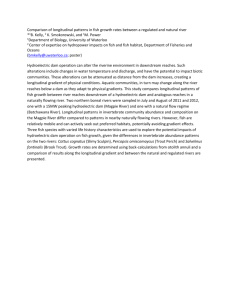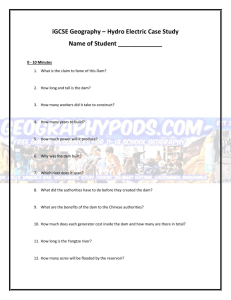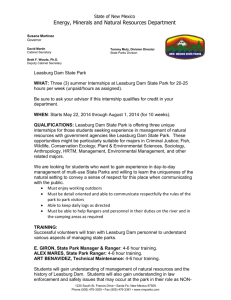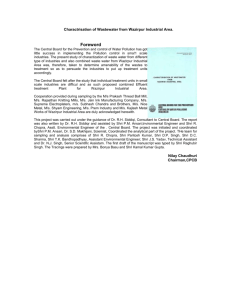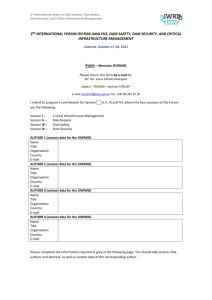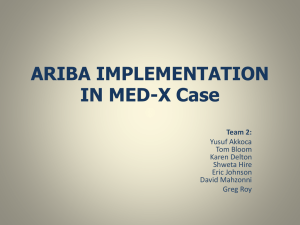3 rd June, 2011
advertisement
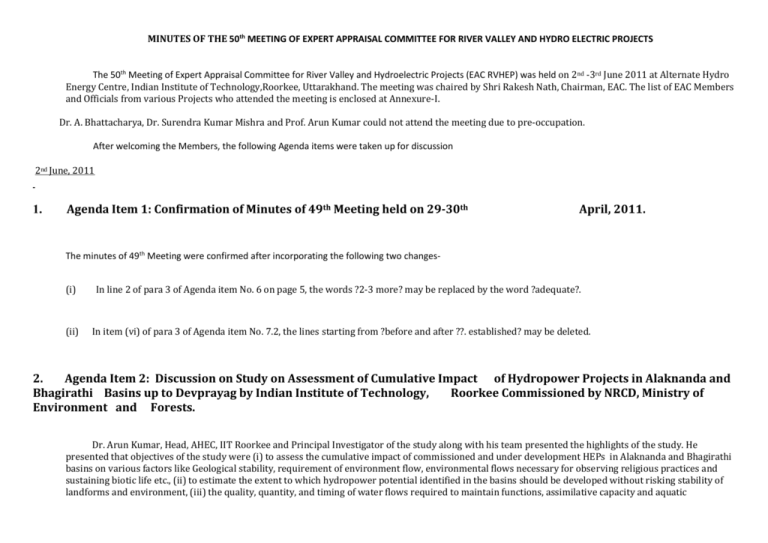
MINUTES OF THE 50th MEETING OF EXPERT APPRAISAL COMMITTEE FOR RIVER VALLEY AND HYDRO ELECTRIC PROJECTS The 50th Meeting of Expert Appraisal Committee for River Valley and Hydroelectric Projects (EAC RVHEP) was held on 2nd -3rd June 2011 at Alternate Hydro Energy Centre, Indian Institute of Technology,Roorkee, Uttarakhand. The meeting was chaired by Shri Rakesh Nath, Chairman, EAC. The list of EAC Members and Officials from various Projects who attended the meeting is enclosed at Annexure-I. Dr. A. Bhattacharya, Dr. Surendra Kumar Mishra and Prof. Arun Kumar could not attend the meeting due to pre-occupation. After welcoming the Members, the following Agenda items were taken up for discussion 2nd June, 2011 1. Agenda Item 1: Confirmation of Minutes of 49th Meeting held on 29-30th April, 2011. The minutes of 49th Meeting were confirmed after incorporating the following two changes(i) In line 2 of para 3 of Agenda item No. 6 on page 5, the words ?2-3 more? may be replaced by the word ?adequate?. (ii) In item (vi) of para 3 of Agenda item No. 7.2, the lines starting from ?before and after ??. established? may be deleted. 2. Agenda Item 2: Discussion on Study on Assessment of Cumulative Impact of Hydropower Projects in Alaknanda and Bhagirathi Basins up to Devprayag by Indian Institute of Technology, Roorkee Commissioned by NRCD, Ministry of Environment and Forests. Dr. Arun Kumar, Head, AHEC, IIT Roorkee and Principal Investigator of the study along with his team presented the highlights of the study. He presented that objectives of the study were (i) to assess the cumulative impact of commissioned and under development HEPs in Alaknanda and Bhagirathi basins on various factors like Geological stability, requirement of environment flow, environmental flows necessary for observing religious practices and sustaining biotic life etc., (ii) to estimate the extent to which hydropower potential identified in the basins should be developed without risking stability of landforms and environment, (iii) the quality, quantity, and timing of water flows required to maintain functions, assimilative capacity and aquatic ecosystems that provide goods and services to people (iv) recommend restrictions, if any, that need to be placed in the development of hydropower in the two basins. He presented that about 10,000 MW capacity (excluding Tehri) is planned to be generated from a total of 69 HEPs on Bhagirathi and Alaknanda Rivers. The HEPs of minimum capacity of 1 MW have been included in the study. Out of these 27 are large HEPs and 42 are small ones. Out of the 27 large HEPs, 4 are already commissioned and construction for 7 is ongoing and 16 HEPs are under preparation. Out of the 42 small HEPs, 9 are commissioned, 7 are under construction and 26 are under preparation. 90% of the hydropower potential is with large HEPs. Out of the studied HEPs, there is none near the sensitive zone. After the detailed presentation, the EAC discussed various issues and observed the following ? (i) The conclusions of the report are more qualitative than quantitative. (ii) There is no clear cut recommendation on environmental flows. Environmental flows have been computed by five different models viz. Hydrological Index Method, Modified Tenant?s Method, Desk Top Approach, Habitat Simulation Methodology, FRANCE and EMC-HMD and results from these models vary tremendously from a minimum of 2.2% to maximum of more than 20% In some methods, it has been shown that even up to 20% of the lean season flow is inadequate. Obviously, a clear recommendation should be made regarding the environmental flow rate in pre-monsoon, monsoon and post monsoon. The selection of environmental flow figures would be arbitrary, unless the most probable and suitable method for Indian conditions is decided. The study does not clearly indicate which model to follow for Indian conditions. It is felt that French conditions may not be applicable for Indian rivers. Further, the Building Block Method, the model generally used for computing environmental flows in other studies and seems to be near to Indian conditions, has not been used. Also the methodology used may be different for different attitudes. The assumptions and hypothesis of these models need to be understood thoroughly before taking any decision for environmental flow for various projects. (iii) The figures given for environmental flow in table 7.16 does not include the figures of EMC-FDC (Flow Duration Curve) method given in table 7.14. Instead it has figures by 75% of Q95 method. It is not clear whether table 7.14 is superfluous or 75% of Q95 method should be discarded. (iv) The conclusion that 30% of the river stretch is available as free flow does not seem to be correct. The Committee had looked into FRL and TWL of each project and found that there is hardly any free river stretch available between the upper most and lower most projects. The report should clearly indicate the free river stretch available between the various projects. (v) The cross section of the river taken at one place for computing the discharge and environmental flow and extrapolating for the project site would result into misleading conclusions. The actual cross section for the various projects has to be considered to derive the expected velocity and depth with the proposed environmental flows. (vi) The study does not take into consideration the flows required in the tributaries as many of the fishes move to these tributaries. (vii) The environmental flows only take into consideration the depth required for movement of the fish, however, lacks details of the flow requirements at various times of the year and at various stretches. However, environmental flow needs to be maintained for the whole aquatic biota. (viii) Environmental flows also need to take into consideration the monsoon flows. Ideally, it should mimic the natural river flow. Importance of monsoon flushing also needs to be given equal importance. The monsoon release has to meet the need of the aquatic biota which primarily needs intermittent large flows in this period. It is considered desirable to allow over the barrier release of adequate monsoon flow volume for keeping the channel boundary favourable for sustaining the aquatic fauna and to maintain channel morphometry. The effect of floods in submergence the wet lands which are important habitat need to be analysed. (ix) The effect of HEPs on primary productivity of the river like fish catch etc. also needs to be studied. (x) As the study area is very diverse and sensitive as far as topographic, geological and environmental parameters are concern, therefore around the year study covering different seasonal variations would be a better illustration, but the present study in general represents winter scenario (NovemberFebruary) only. (xi) A fast flowing turbulent river with cold temperature also supports some cold tolerant fishes like loaches and snow trouts (Schizothorax and Schizothoraichthys spp), hence these species may be present in upper reaches of Alaknanda-Bhagirathi rivers particularly during summers. (xii) Besides other factors, the available fish diversity, presence of over-wintering/ migratory fishes- mahseer, snow-trout, their body size, presence of breeding and feeding grounds must also be considered in quantifying downstream flow. (xiii) The Garhwal Himalayan waters are reportedly rich in piscine diversity (Hora and Mukerji, 1936; Badola and Pant, 1973; Badola, 1975; Badola and Singh, 1977a & b); Singh, H.R.; S.P.Badola andA.K.Dobriyal, 1987), hence require efforts for conservation. (xiv) The minimum hydrological requirements for macro-invertebrates in rhirhthronic zones reported to vary from 15-50 cm with different velocity (25100 cm s-1). The requirements shown in the report for the fish are also similar to that. But the region harbour diverse fish species varying from small sized loaches to mighty mahseers. The loaches are indicators of perennial water bodies as they thrive in shallow sheet of semi-stagnant water, while maheer need fast flowing rivers, rivulets and streams for migratory run and shallow side pools for breeding and feeding. Therefore the different life stages and size of the fish should be considered for estimation of environmental flow requirement. (xv) There are many sites in the Garhwal region having pristine habitats, esteem religious, aesthetic & tourism importance. Gangotri, Yamunotri, Badrinath and Kedarnath are four top Hindu?s religious shrines. Millions of people visit these places every year particularly during summer. The rivers, rivulets and streams traversing through these shrines (or near the roads to these shrines) have high sensitivity. Hence besides environmental flow (based on downstream aquatic liabilities) the above points need also be considered for estimation of downstream flow. (xvi) Periphytic assemblage on and underneath the bed rocks, boulders, cobbles forms an important food material for snow-trouts, and some other hill stream fishes, hence need also to be studied under CIA. Besides the above observations, some of the observations of Mr. A.K. Bhattacharya who could not attend the meeting are enclosed at Annexure-II. The Committee also felt that recommendations of WII also need to be looked into as WII has also carried out some studies on environmental flows and free rivers flow. WII may be requested to present their study in the next meeting. 3. Agenda Item 3: Discussion on Final Report of the Study on Cumulative by WAPCOS. Impact Assessment of Bichom River Basin Due to last minute health problem, Dr. Aman Sharma from WAPCOS could not attend the meeting hence the presentation was deferred for next meeting. 4. Agenda Item 4: Consideration of Project Proposals for Scoping and Environment Clearance. 4.1 Consideration of Proposals for Scoping & Approval of TORs 4.1.1 Change in the Scope of 4x115 MW Kolodyne?II HEP on River Kolodyne in Lawngtlai/saiha district of Mizoram by M/s NTPC . The Project Proponent could not attend the meeting hence deferred for the next meeting. 4.1.2. Sawalkote 1200 MW Hydroelectric Power Project on River Chenab in Ramban District of Jammu & Kashmir by M/s Jammu & Kashmir State Power Development Corporation Limited ? For TORs. The Project proposal was earlier considered in 49th Meeting of EAC held on 29th ? 30th April, 2011. The Committee had desired certain additional information which was discussed with the Project Proponent. JKSPDC submitted the revised Form 1 along with the TORs on the lines of model TORs. The PP submitted the break-up of the land requirement. Out of 1099 ha of total land, 900 ha would be the submergence area and 199 ha shall be the other area. 600 ha is the forest land. Details of various alternatives explored for the project were discussed along with the distances between upstream and downstream projects. It was submitted that there is a free river stretch of 4.42 km available from Baglihar upstream HEP and about 18 km between Sawalkote and the Salal i.e. the downstream project. An environmental release of 26.90 cumecs (20% of minimum discharge) is proposed. The Committee reviewed the Hydrological series and found this to be in line. The Committee felt that in view of a long time lapse between the earlier EIA study the project cannot be exempted from collecting fresh data for EIA study. The updated Hydrological studies approved by CWC have been submitted to MoEF. The Committee approved the draft TORs submitted by the PP along with the general conditions. 3rd June, 2011 4.2 4.2.1 Final Environment Clearance Reappraisal of Bhilingana Project- Direction of the Hon?ble High Court of Uttrakhand at Nanital. The Project Proponent did not attend the meeting hence deferred for the next meeting. The Project Proponent did not inform to the MoEF about their absence. 4.2.2 Dhamwari Sunda 2x35 MW Hydro Electric Project on River Pabbar in Romai Village, Shimla, H.P. by Dhamwari Power Co. Pvt. Ltd. ? For Environment Clearance. M/S Dhamwari Power Company (Pvt.) Ltd. proposes a 2x35 MW Hydropower Project on River Pabbar -a perennial river and a tributary of Tons River which is a major tributary of Yamuna River. The Project is in Dhamwari village in Shimla District of Himachal Pradesh and is a Run-of-River type scheme. An un-gated 92 m long concrete dam of 28 m height from the deepest foundation level will be constructed. The FRL and MDDL for the Project are EL 2180.0 m and EL 2174.0m respectively and gross head will be 420.60 m with design flood is 1300 cumecs. Tangnu Romai 50 MW HEP and ChirgaonMajhgaon 46 MW HEP are upstream and downstream of the project. The Tangnu Romai is under construction while Chirgaon is under investigation. FRLs of the upstream and downstream HEPs are EL 2190m and EL 2180m respectively and the TWL for upstream project has not yet been fixed and the same for downstream project is EL 1747.35m. One surface de-silting chambers has been proposed. The Head Race Tunnel (HRT) will be of 10.14 km length and 3.0 m dia having a design discharge of 19.83 cumecs. Open to air Surge Shaft will be of 61 m high and pressure shaft will be of 988 m long. Power House will be surface type on right bank of river having 2x35 MW Pelton Turbines. The total cost of the project is Rs. 489.82 Crores including Rs. 24.49 Crores for EMP and Rs.7.35 Crores for local area development activities (LADA). No national park, wild life/bird sanctuary, biosphere reserve, monuments, religious places etc. exists within 10 km of the project component. Techno-Economic clearance has been accorded by Directorate of Energy, Govt. of Himachal Pradesh on 10.01.2011. NOC from the District Surveillance Officer, Shimla regarding occurrence of serious epidemic, Divisional Forest Officer, Rohru regarding rare or endangered species of flora and fauna and Language and Culture Department, GoHP has been obtained. First stage forest clearance for 18.123 ha has been recommended by the State Government to MoEF. Public Hearing for the Project was held on 27.10.2010. Total land requirement for the Project is 23.3025 ha out of which 5.1795 ha is private land and 18.123 ha is forest land. There is no R & R or displacement of any family is involved in the project. Compensatory afforestation over 37 ha of land will be undertaken. For Hydrolgy, data of last 33 years from three rain gauge discharge (G&D) stations, located at Tangnu, Dhamwari and Mandly on the Pabbar River were used in deriving the extended flow series data. The average flow during December to February was estimated as 4.82m3s-1. In addition to the data from these three stations, flow data from a station at Tuini near the confluence of the Pabbar River with the Tons river, maintained by the Central Water Commission (CWC) were also used. The PP has established a Gauge station near Diversion site and a meterological station in village Pekha, upstream of diversion structure. Total catchment area at diversion site is 212.48 sq km out of which 14% is snow bound. CAT plan for soil conservation in the catchment area has been prepared in accordance with Guide lines and Notification No. FFE-B-F-(2)-72/2004-Pt-II dated 30.09.2009 of Government of Himachal Pradesh. Rs. 12.44 Crore which is more than 2.5% of the total project cost has been provided for CAT plan. Nine perennial nallahas join the river from the dam site till the TRT, the first one at 0.5 km from the dam, adding 2.86 m3/s as per 90% dependable flow. As per the Environment Flow Study carried out by Department of Water Resource Development & Management, IIT, Roorkee, the environmental flow of 1 m3/s i.e. 20.83% of average discharge during lean months (December ? February) is proposed by the Proponent for sustenance and maintenance of riverine ecology. Fund has been provisioned in EMP for the development and maintenance of Aquatic life. A trout fish farm has been established at Dhamwari onKhanyara Khad by HP Fishery Department. Rooted aquatic vegetation is sparse due to turbulent character of the river flow and turbidity of water. The expected muck generation shall be 8,73,523 cum, out of which 2,48,633 cum will be utilized in the project and 6,24,890 cum will be disposed off in 10.912 ha of area. Nine muck disposal site have been identified with the approval of State Pollution Control board. The water and air quality and noise levels in the study area are within the permissible limits. The area has five main types of forests ranging from Moist ? Deodar (Cedrus deodara), Western mixed coniferous, moist temperate deciduous, low level blue pine (pinus wallichiana) and Birch Rhododendron Scrub. There is no wildlife centaury or national park within 10 km distance from the Project. There is no rare or endangered species of flora or fauna found in the project area. About 1950 labour will be deployed during the construction phase. STP and solid waste collection and disposal will be provided for waste water treatment and solid waste management. After detailed deliberation, the Committee desired the following clarifications/ additional information ? (i) It is observed that the Hydrological series is over estimated. CWC State hydrological data may be provided. The hydrological series needs to be established /compared with the observed hydrological data of the PP. (ii) The distance of Govind Wildlife Sanctuary in the State of Uttrakhand from the Project Proponents may be provided. (iii) Cross section of the river to the scale may be submitted. (iv) In table 3 - 53 for flora & fauna, only 20 birds species have been mentioned which seems in adequate. The same needs to be re-checked. The mention of number of trees is different in different seasons. The justification for the same may be provided. (v) It is mentioned that Trout Fish will not be available in the river. The availability of fish species need to be rechecked. (vi) Dam break analysis may be provided. (vii) Muck Management plan with L Sections of each muck disposal site providing distance from HFL of river may be submitted. (viii) Muck reclamation cost may be worked out and included in muck disposal cost. Accordingly, revised cost for EMP, if needed, may be provided. The Proposal shall be reconsidered after submission of the above mentioned information. 4.3. Reconsideration for Final Environment Clearance 4.3.1. Sapli Dam Upper Penganga Hydroelectric Project Stage-II on Kayadhu River in District Hingoli, Maharashtra by M/s Godavari Marathwada Irrigation Development Corporation. The proposal was considered by the EAC in its meeting held on 19th January, 2010. The Committee noted that the EIA report which was submitted to SEIAA was for 600 ha only. The Public hearing in HingoliDistrict was held with this EIA report and no public hearing was held in other District i.e. Nanded. In view of this, the Committee had desired that the Project Proponent should submit the proposal for command area of 28,600 ha as per the EIA Notification, 2006 for further consideration of the Committee. Accordingly, the Proponent has submitted revised report and public hearing conducted in other District also. The project was then considered by the Committee in its 46th Meeting held on 21st ? 22nd January, 2011. The Committed had desired a few clarifications/additional information which was now discussed in this meeting. The details of Isapur dam, its water availability, index map etc. were presented. It was informed by the PP that Stage II of the project for which clearance is sought involves construction of Sapli Dam on KayaduRiver with a Feeder Canal of 6 km irrigating 600 ha of land. The water availability at Isapur Dam as per 75% dependability and 50% dependability are 576.69 MCum and 902.51 MCum and for Sapli Dam it is 260.24MCum and 391.14 MCum respectively. The Catchment area for Isapur Dam is 4636 Sq. Km. and that for Sapli Dam, it is 1593 Sq. Km. The gross and live storage for Sapli Dam shall be 8.5 TMC and 7.0 TMC respectively. The height of the dam shall be 20.80 m and the length shall be 3130 m with spill way length of 184 m. The Dam shall have 12 gates. The construction of Isapur Dam and Canal works has been completed while Disnet is under completion. The work for Sapli Dam and its feeder canal has not yet started, as apprehended earlier. The benefit of existing cropping pattern is Rs. 9417 lakhs while benefits of the proposed cropping pattern is Rs. 63065 lakhs, therefore, BC ratio is 1.574. Pressurised irrigation shall be used and training for the same shall be imparted by WALMI Aurangabad. Separate SIA was submitted and demography of the project villages was discussed along with plan for land acquisition and rehabilitation/resettlement. Regarding point wise reply to the representation made by Sapli Dharan Sangharsh Samitee, it was informed that the same representation was given to the District Collector of Nanded District who has replied to the Samitee that the public hearing is as per the rules and there is no question of cancelling public hearing at Umri, Nanded. They further submitted that there is no violation of rules ? procedures. The Committee felt that population data provided in SIA is out dated and now data as per the new census should be provided. It was mentioned that no sample survey has been done for which PP informed that door to door survey has been carried out. The Committee was satisfied with the clarifications provided by the PP and recommended the project for environment clearance subject to the submission of revised SIA to the Ministry within a week. The PP has submitted the same. The meeting ended with vote of thanks to the Chairman. The next meeting of the Committee shall be held on 15th - 16th July, 2011. *************** Annexure I List of EAC Members and Proponents who attended 50th Meeting of Expert Appraisal Committee for River Valley & Hydroelectric Power Projects held on 2 nd & 3rd June 2011 Members of EAC 1. Shri Rakesh Nath- Chairman 2. Dr. B.P. Das- Vice-Chairman 3. Dr. K.D. Joshi - Member 4. Shri Dhananjay Mohan ?Member 5. Dr. Mrs. Maitrayee Choudhary ? Member 6. Shri G.L. Bansal, Member 7. Ms. Sanchita Jindal, Director, MoEF - Member Secretary 8. Dr. Subba Rao, MoEF Cumulative Study of HEP on Alaknanda and Bhagirathi River Basins 1. 2. 3. 4. 5. 6. Dr. Arun Kumar, AHEC, IIT, Roorkee Dr. D.k. Srivastava Prof. Ramesh C. Sharma Dr. Deepak Khare Dr. M.P. Sharma Prof. S.K. Jain Sawalkote HEP, J&K 1. 2. 3. 4. Er. A.K. Garyali, Executive Engineer Dr. G.A. Mukthar, Chief Geologist Er. Mohemmad Hussain Teli, Deputy General Manager Er. Vijay Nagri, Ex. Engineer (JKSPDC) Dhamwari Sunda HEP 1. 2. 3. 4. 5. 6. 7. 8. Shri G.K. Malhotra, General Manager Shri Chandrashekhar, Assistant General Manager Shri Rakesh Verma, Manager Civil Shri Rajesh Parihar, Project Officer Dr. Rakesh Kaur, Consultant (ITC PKL) Lab Dr. Monmoy Gowsami, Chief Manager (Tata Consultant Engineer) Shri S.K. Malik, ITC, PKL (Lab) Shri Pradeep Rana, Consultant (ITC PKL) Sapli Dam Upper Pan Ganga HEP -Stage II, Maharashtra 1. 2. 3. 4. 5. 6. 7. Shri B.N. Kandarphale, Executive Director, GMIDC, Aurangabad Shri R.B. Ghote, Chief Engineer, LCA, Maharashtra Shri S.D. Chate, Superintendent Engineer, UPP Circle, Nanded Shri H.W. Solge, Executive Engineer, UPP Division, Hingoli (Maharashtra) Shri P.G. Kurtadikar, Sub.Division Engineer, UPP Division, Hingoli (Maharashtra) Dr. Sarang Kulkari, Scitech, Pune Shri Yeoli, Adikrao, Scitech, Pune ****** Annexure-II Observations of Shri A.K . Bhattacharya, Member, EAC on study on Cumulative Impact Assessment of HEPs on Bhagirathi and Alaknanda Rivers by IIT Roorkee. i. Limitation of satellite data is said to be a reason precluding the possibility of statistical analysis of decadal change of land use data (Page E-3). ii. Statistical analysis for comparison is not possible with only 2 years data (2000 and 2009). It is not clear if the satellite data on land use for the years in between the two limiting years and for comparable time of the year was available. iii. Land use data perhaps are also available from the record of the State Government Departments (mainly Forest and Agriculture) based on samples of actual recorded information. Were these avenues tapped? iv. On the same Page (E ? 3), it is recommended that RS & GIS studies be carried out every 3 to 5 years. The MoEF has to decide if this recommendation is useful, as to the best of my knowledge, MoEF does not undertake such studies. v. Can the MoEF use this recommendation to request the appropriate agencies (NRSA, ISRO and may be others) to conduct such studies and share the information with MoEF. DoesMoEF have the logistics to use the information to frame some kind of a Guideline to permit or limit hydro power development in a basin? vi. On Page ES ? 4, the map is labeled as Figure 4 at the inset and as Figure 2 outside. Discounting this anomaly, which may be trivial and due to typographical error, the major concerns are: (a) Already there are several under-construction projects in the ?Protected area? (7 in the protected area and 3 border line cases); (b) There are a large number of projects, both under-construction and commissioned, within the dense forest and (c) There are too many under-construction projects within a relatively short reach of the Bhagirathi and Bhilangana Rivers and on the tributary Asi Ganga of Bhagirathi River. Further ahead in the report, it will be examined if probable impacts of closely spaced hydro power projects under construction on the river flow regime, aquatic life, water quality in the river, land slide, muck disposal, etc., have been discussed. vii. As for the project locations in protected and dense forest areas, the MoEF may perhaps examine the cases to verify if all necessary clearances had been taken by the respective project proponents before starting construction. viii. The recommendation ?a? on page E ? 7 under Seismological Aspects is already being followed by all the hydro power developers whenever the dam/barrage height exceeds a certain limit (which I recall as 20 m from the river bed). The report, however, does not explicitly say if for a downstream project the seismicity effect (which may result in dam failure in extreme case) of the upstream projects need also to be considered. This issue is of concern in closely spaced projects in a cascade system. The experience in EAC has been that such eventualities are discounted by the downstream project authority and EAC is handicapped, as there is no guide line in this regard. ix. The two paragraphs and Section 7.1 dealing with Environmental Flow are informative and imply that this issue has been dwelt upon in detail in the main report. Since the main report is not available with me, I cannot make any further observation on this issue. x. It is, however, pertinent to point out that there is another dimension of the environmental flow (in addition to the minimum flow requirement) and that is related to the operational schedule of the hydro power plants, particularly if it is a large project and the plant caters to the peak power demand. In several of such cases, the EAC found that diurnal variation in river flow fluctuates by more than one order of magnitude between the time of storage and the time of release (for peak power generation). The EAC believes that such huge fluctuations in the diurnal flow may be extremely unfriendly to the aquatic fauna, as: (a) It may wash out the small fish to distant and unknown places and (b) It may wash out the fish feed from its usual places of occurrence that will inconvenience even the larger fish population. The dam has already imposed severe restriction to fish movement and migration, which may be further aggravate due to power plant operation. Thus, the EAC looks for some guide line on the maximum permissible diurnal flow variation in a river downstream to the dam taking into consideration the usual fish habitats there. If this guide line is available then it will be possible for the EAC to advise the project proponent on the maximum power that may be generated during peaking hours. This information will also be useful to decide the plant capacity at the time of design. It is the EAC?s experience that a high installed capacity (which is mostly the case), influences the plant operators to use maximum possible flow to generate maximum possible power during the peaking time. If this issue has been presented and discussed in the Main Report, then it is fine. xi. Para 7.3, towards the end (Page E ? 11) recognizes river fragmentation an issue to be concerned with. But the implication of the last sentence: ?This fragmentation, if unattended can be very harmful for the aquatic life.? is not clear to me. How could this be attended, by just ensuring minimum environmental flow? That is only for survival of fish and does not help in their proliferation or migration. Interference to the normal river flow is associated with all the HEPs, to varying extent, from a few kilometers to more than 30 km (including the reservoir water spread length at FRL). For tall dams, fish pass is unsuitable. xii. The concept of ROR is also interpreted differently by different project proponents. The EAC has come across the ?so-called? ROR projects where the permanent storage depth at MDDL is substantial. It is only beyond MDDL that water is temporarily stored and then let out to flow toward the power plant. Such projects, though being named ROR, will store sediment coming from upstream. xiii. Any river stretch harbouring habitation near the banks is subject to pollution due to waste water flow from the inhabitated area. If this stretch also happens to be a flow-deprived section of the river due to water diversion toward the hydro power plant, then the occurrence of pollution hazard is foretold. EAC has been grappling with such issues for quite some time in the past to decide as to what extent the river stretch between two contiguous projects must be left to flow as in the pre-project condition, but could come out only with some adhoc suggestions such as keeping a minimum 1 km river stretch between two contiguous projects undisturbed and unaffected by the project at the upstream and at the downstream. xiv. Recommendation No. 17 on Page 12-25 may be hazardous to adopt, particularly in those cases where the affected reach (flow-deprived reach in the lean season) experiences high floods during the monsoon season, simply because they may be washed away. ********
